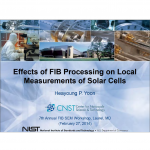
“Effects of Focused-Ion-Beam Processing on Local Measurements of Semiconductor Solar Cells”, H. P. Yoon, P. M. Haney, J. Schumacher, K. Siebein, Y. Yoon, and N. B. Zhitenev, presented by H. Yoon at the 7th Annual FIB SEM Workshop in Laurel, MD, February 2014.
1. Center for Nanoscale Science and Technology, National Institute of Standards and Technology, Gaithersburg, Maryland, 20899, USA. 2. Maryland Nanocenter, University of Maryland, College Park, Maryland, 20742, USA
ABSTRACT. Quantitative determination of electronic properties at high spatial resolution is crucial for the development of high-efficiency solar cells. Electron beam induced current (EBIC) is a powerful technique in which electron-hole pairs are created in proximity to an exposed surface, and the carrier collection efficiency is measured as a function of excitation position. Cross-sections of device are often created by focused ion beams (FIB) due to the flexibility of the patterning and milling processes. However, the irradiating Ga ions of the FIB fabrication may introduce unintended artifacts, affecting local electronic properties. In this talk, we discuss the impact of the FIB process observed in EBIC measurements and two-dimensional finite element simulations. A series of EBIC data was obtained on a single crystalline solar cell at different electron beam voltages and beam currents to examine the depth and carrier injection level dependence inside the depletion region and away from the p-n junction. Quantitative analysis shows that the EBIC efficiency of the FIB sample is much lower (< 40 %) than that of the cleaved sample (100%) at low beam voltages (<10 keV). We discuss the effects of FIB processing of other types of photovoltaic devices including CdTe and CIGS solar cells.

